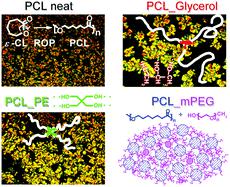当前位置:
X-MOL 学术
›
Soft Matter
›
论文详情
Our official English website, www.x-mol.net, welcomes your feedback! (Note: you will need to create a separate account there.)
Synthesis, crystallization, and molecular mobility in poly(ε-caprolactone) copolyesters of different architectures for biomedical applications studied by calorimetry and dielectric spectroscopy.
Soft Matter ( IF 3.4 ) Pub Date : 2020-08-10 , DOI: 10.1039/d0sm01195a Evi Christodoulou 1 , Panagiotis A Klonos 2 , Kostas Tsachouridis 1 , Alexandra Zamboulis 1 , Apostolos Kyritsis 3 , Dimitrios N Bikiaris 1
Soft Matter ( IF 3.4 ) Pub Date : 2020-08-10 , DOI: 10.1039/d0sm01195a Evi Christodoulou 1 , Panagiotis A Klonos 2 , Kostas Tsachouridis 1 , Alexandra Zamboulis 1 , Apostolos Kyritsis 3 , Dimitrios N Bikiaris 1
Affiliation

|
In this work, we synthesized poly(ε-caprolactone) (PCL) and three copolyesters of different architectures based on three different alcohols, namely a three arm-copolymer based on 1% glycerol (PCL_Gly), a four arm-copolymer based on 1% pentaerythrytol (PCL_PE), and a linear block copolymer based on ∼50% methoxy-poly(ethylene glycol) (PCL_mPEG), all simultaneously with the ring opening polymerization (ROP) of PCL. Due to their biocompatibility and low toxicity, these systems are envisaged for use in drug delivery and tissue engineering applications. Due to the in situ ROP during the copolyesters synthesis, the molecular weight of PCL, Wm initially ∼62 kg mol−1, drops in the copolymers from ∼60k down to ∼5k. For the structure-properties investigation we employed differential scanning calorimetry (DSC and TMDSC), X-ray diffraction (XRD), nuclear magnetic resonance (NMR), Fourier transform infra red (FTIR) spectroscopy, polarized optical microscopy (POM), broadband dielectric spectroscopy (BDS) and isothermal water sorption. DSC revealed that the crystalline fraction of PCL increases whereas the crystallization rate drops in the copolymers in the order PCL ∼ PCL_Gly > PCL_PE ≫ PCL_mPEG, which coincides with that of decreasing Wm. In PCL_mPEG the major amount of PCL (87%) was found to crystallize while the majority of mPEG (92%) was found amorphous exhibiting constrained amorphous mobility and severely slower/weaker crystallization as compared to neat mPEG. Segmental dynamics in BDS, in agreement with DSC, is similar and in general slow for the samples of star-like structure for Wm ≥ 30k arising from PCL, whereas it is severely faster and enhanced in strength for the linear PCL_mPEG (lower Wm) copolymer arising from mPEG. For the latter system, the data provide indications for the formation of complex structures consisting of many small PCL crystallites surrounded by amorphous mPEG segments with constrained dynamics and severely suppressed hydrophilicity. These effects cannot be easily assessed by conventional XRD and POM, confirming the power of the dielectric technique. The overall recordings indicated that the different polymer architecture results in severe changes in the semicrystalline morphology, which demonstrates the potential for tuning the final product performance (permeability, mechanical).
中文翻译:

通过量热法和介电光谱法研究了生物医学应用不同结构的聚(ε-己内酯)共聚酯中的合成,结晶和分子迁移率。
在这项工作中,我们基于三种不同的醇合成了聚(ε-己内酯)(PCL)和三种不同结构的共聚酯,即基于1%甘油的三臂共聚物(PCL_Gly),基于1%的四臂共聚物%季戊四醇(PCL_PE)和基于约50%甲氧基-聚(乙二醇)的线性嵌段共聚物(PCL_mPEG),同时与PCL的开环聚合(ROP)同时进行。由于它们的生物相容性和低毒性,这些系统被设想用于药物输送和组织工程应用。由于共聚酯合成过程中的原位ROP,PCL,W m的分子量最初约为62 kg mol -1,从约60k下降到约5k的共聚物。对于结构特性研究,我们使用了差示扫描量热法(DSC和TMDSC),X射线衍射(XRD),核磁共振(NMR),傅立叶变换红外(FTIR)光谱,偏振光学显微镜(POM),宽带电介质光谱(BDS)和等温水吸附。DSC显示,共聚物中PCL的结晶分数增加,而结晶速率下降,顺序为PCL〜PCL_Gly> PCL_PE≫ PCL_mPEG,这与W m的降低相吻合。。与纯mPEG相比,在PCL_mPEG中发现大量PCL(87%)结晶,而发现大多数mPEG(92%)表现出受约束的非晶态迁移率并严重减慢/减弱了结晶。在BDS节段性动力学,与DSC的协议,是类似的,在一般的慢为星形结构的样品W¯¯米≥30K从PCL引起的,而这是严重更快,强度增强了对线性PCL_mPEG(降低w ^米)衍生自mPEG的共聚物。对于后一种系统,数据提供了形成复杂结构的迹象,该结构由许多小的PCL晶体组成,周围环绕着无定形的mPEG片段,动力学受限,亲水性受到严重抑制。传统的XRD和POM无法轻松评估这些影响,从而证实了介电技术的强大功能。总体记录表明,不同的聚合物结构会导致半结晶形态发生严重变化,这表明有可能调节最终产品的性能(渗透率,机械性能)。
更新日期:2020-09-16
中文翻译:

通过量热法和介电光谱法研究了生物医学应用不同结构的聚(ε-己内酯)共聚酯中的合成,结晶和分子迁移率。
在这项工作中,我们基于三种不同的醇合成了聚(ε-己内酯)(PCL)和三种不同结构的共聚酯,即基于1%甘油的三臂共聚物(PCL_Gly),基于1%的四臂共聚物%季戊四醇(PCL_PE)和基于约50%甲氧基-聚(乙二醇)的线性嵌段共聚物(PCL_mPEG),同时与PCL的开环聚合(ROP)同时进行。由于它们的生物相容性和低毒性,这些系统被设想用于药物输送和组织工程应用。由于共聚酯合成过程中的原位ROP,PCL,W m的分子量最初约为62 kg mol -1,从约60k下降到约5k的共聚物。对于结构特性研究,我们使用了差示扫描量热法(DSC和TMDSC),X射线衍射(XRD),核磁共振(NMR),傅立叶变换红外(FTIR)光谱,偏振光学显微镜(POM),宽带电介质光谱(BDS)和等温水吸附。DSC显示,共聚物中PCL的结晶分数增加,而结晶速率下降,顺序为PCL〜PCL_Gly> PCL_PE≫ PCL_mPEG,这与W m的降低相吻合。。与纯mPEG相比,在PCL_mPEG中发现大量PCL(87%)结晶,而发现大多数mPEG(92%)表现出受约束的非晶态迁移率并严重减慢/减弱了结晶。在BDS节段性动力学,与DSC的协议,是类似的,在一般的慢为星形结构的样品W¯¯米≥30K从PCL引起的,而这是严重更快,强度增强了对线性PCL_mPEG(降低w ^米)衍生自mPEG的共聚物。对于后一种系统,数据提供了形成复杂结构的迹象,该结构由许多小的PCL晶体组成,周围环绕着无定形的mPEG片段,动力学受限,亲水性受到严重抑制。传统的XRD和POM无法轻松评估这些影响,从而证实了介电技术的强大功能。总体记录表明,不同的聚合物结构会导致半结晶形态发生严重变化,这表明有可能调节最终产品的性能(渗透率,机械性能)。



























 京公网安备 11010802027423号
京公网安备 11010802027423号